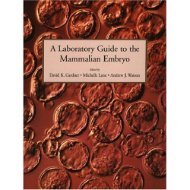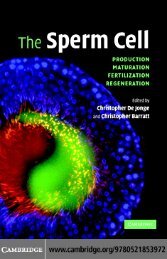- Page 1: METHODS IN MOLECULAR BIOLOGY 368 C
- Page 5: M E T H O D S I N M O L E C U L A R
- Page 8 and 9: © 2007 Humana Press Inc. 999 River
- Page 11 and 12: Contents Preface ..................
- Page 13 and 14: Contributors SUE ARMITAGE • Natio
- Page 15 and 16: Glossary of Specialized Terms Cell
- Page 17 and 18: 2 Stacey and Day However, such coll
- Page 19 and 20: 4 Stacey and Day bank prepared meet
- Page 21 and 22: 6 Table 2 Standards for Cell Bankin
- Page 23 and 24: 8 Stacey and Day Table 3 Examples o
- Page 25 and 26: 10 Table 4 Typical Storage and Tran
- Page 27 and 28: 12 Stacey and Day 5. Hebert, P. D.,
- Page 29: 14 Stacey and Day 38. Stacey, G. N.
- Page 32 and 33: 16 Adams inactivation, and is more
- Page 34 and 35: 18 Adams However, freeze-drying is
- Page 36 and 37: 20 Adams chambered vials, and prefi
- Page 40 and 41: 24 Adams Although heat annealing wi
- Page 42 and 43: 26 Adams noncrystalline, glass. Whe
- Page 44 and 45: 28 Adams system, or (2) isolating t
- Page 46 and 47: 30 Adams moisture, is converted int
- Page 48 and 49: 32 Adams 4. Reconstituting the Prod
- Page 50 and 51: 34 Adams 1. Temperature. Whereas a
- Page 52 and 53: 36 Adams 13. Mackenzie, A. P. (1977
- Page 54 and 55: 38 Adams Pharmaceutical and Biologi
- Page 56 and 57: 40 Pegg of diffusion and osmosis ha
- Page 58 and 59: 42 Pegg Fig. 1. Schematic represent
- Page 60 and 61: 44 Pegg Fig. 4. Human erythrocytes
- Page 62 and 63: 46 Pegg Fig. 6. Hemolysis observed
- Page 64 and 65: 48 Pegg solutes. Biological systems
- Page 66 and 67: 50 Pegg reach their final volume. T
- Page 68 and 69: 52 Pegg is frozen is outside the sy
- Page 70 and 71: 54 Pegg Fig. 10. Diagram constructe
- Page 72 and 73: 56 Pegg 5. Pegg, D. E. (1972) Cryob
- Page 75 and 76: 4 Lyophilization of Proteins Paul M
- Page 77 and 78: Lyophilization of Proteins 61 In or
- Page 79 and 80: Lyophilization of Proteins 63 Fig.1
- Page 81 and 82: Lyophilization of Proteins 65 A num
- Page 83 and 84: Lyophilization of Proteins 67 Fig.
- Page 85 and 86: Lyophilization of Proteins 69 Large
- Page 87 and 88: Lyophilization of Proteins 71 The t
- Page 89 and 90:
5 Vacuum-Drying and Cryopreservatio
- Page 91 and 92:
Cryopreservation of Prokaryotes 75
- Page 93 and 94:
Cryopreservation of Prokaryotes 77
- Page 95 and 96:
Cryopreservation of Prokaryotes 79
- Page 97 and 98:
Cryopreservation of Prokaryotes 81
- Page 99 and 100:
Cryopreservation of Prokaryotes 83
- Page 101 and 102:
Cryopreservation of Prokaryotes 85
- Page 103 and 104:
Cryopreservation of Prokaryotes 87
- Page 105 and 106:
Cryopreservation of Prokaryotes 89
- Page 107 and 108:
Cryopreservation of Prokaryotes 91
- Page 109 and 110:
Cryopreservation of Prokaryotes 93
- Page 111 and 112:
Cryopreservation of Prokaryotes 95
- Page 113:
Cryopreservation of Prokaryotes 97
- Page 116 and 117:
100 Bond The removed water vapor is
- Page 118 and 119:
102 Bond Fig. 1. Centrifuge head wi
- Page 120 and 121:
104 Bond Fig. 3. 8. Removal of ampo
- Page 122 and 123:
106 Bond 5. Both lyoprotectants lis
- Page 125 and 126:
7 Cryopreservation of Yeast Culture
- Page 127 and 128:
Cryopreservation of Yeast Cultures
- Page 129 and 130:
Cryopreservation of Yeast Cultures
- Page 131 and 132:
Cryopreservation of Yeast Cultures
- Page 133:
Cryopreservation of Yeast Cultures
- Page 136 and 137:
120 Tan, van Ingen, and Stalpers is
- Page 138 and 139:
122 Tan, van Ingen, and Stalpers Ta
- Page 140 and 141:
124 Tan, van Ingen, and Stalpers an
- Page 143 and 144:
9 Cryopreservation and Freeze-Dryin
- Page 145 and 146:
Centrifugal and Shelf Freeze-Drying
- Page 147 and 148:
Centrifugal and Shelf Freeze-Drying
- Page 149 and 150:
Centrifugal and Shelf Freeze-Drying
- Page 151 and 152:
Centrifugal and Shelf Freeze-Drying
- Page 153 and 154:
Centrifugal and Shelf Freeze-Drying
- Page 155 and 156:
Centrifugal and Shelf Freeze-Drying
- Page 157 and 158:
10 Cryopreservation of Microalgae a
- Page 159 and 160:
Cryopreservation of Microalgae and
- Page 161 and 162:
Cryopreservation of Microalgae and
- Page 163 and 164:
Cryopreservation of Microalgae and
- Page 165 and 166:
Cryopreservation of Microalgae and
- Page 167:
Cryopreservation of Microalgae and
- Page 170 and 171:
154 Grout 2. The production of spec
- Page 172 and 173:
156 Grout must undergo a similar tr
- Page 174 and 175:
158 Grout 9. To recover the cells,
- Page 176 and 177:
160 Grout 13. Mohamed, S. V., Sung,
- Page 179 and 180:
12 Cryopreservation of Shoot Tips a
- Page 181 and 182:
Cryopreservation of Shoot Tips and
- Page 183 and 184:
Cryopreservation of Shoot Tips and
- Page 185 and 186:
Cryopreservation of Shoot Tips and
- Page 187 and 188:
Cryopreservation of Shoot Tips and
- Page 189 and 190:
Cryopreservation of Shoot Tips and
- Page 191 and 192:
Cryopreservation of Shoot Tips and
- Page 193 and 194:
Cryopreservation of Shoot Tips and
- Page 195 and 196:
Cryopreservation of Shoot Tips and
- Page 197 and 198:
Cryopreservation of Shoot Tips and
- Page 199:
Cryopreservation of Shoot Tips and
- Page 202 and 203:
186 Pritchard or other nonconventio
- Page 204 and 205:
188 Pritchard Table 1 Examples of S
- Page 206 and 207:
190 Pritchard 3.1.2.1. MOIST SEEDS
- Page 208 and 209:
192 Pritchard 2. Assume that the mo
- Page 210 and 211:
194 Pritchard 4. Manipulation of se
- Page 212 and 213:
196 Pritchard (see Note 9). Lipid-r
- Page 214 and 215:
198 Pritchard 10. Daws, M. I., Clel
- Page 216 and 217:
200 Pritchard 41. Vasquez, N., Sala
- Page 219 and 220:
14 Cryopreservation of Fish Sperm E
- Page 221 and 222:
Cryopreservation of Fish Sperm 205
- Page 223 and 224:
Cryopreservation of Fish Sperm 207
- Page 225 and 226:
Cryopreservation of Fish Sperm 209
- Page 227 and 228:
Cryopreservation of Fish Sperm 211
- Page 229 and 230:
Cryopreservation of Fish Sperm 213
- Page 231 and 232:
Cryopreservation of Fish Sperm 215
- Page 233:
Cryopreservation of Fish Sperm 217
- Page 236 and 237:
220 Wishart outlined previously. Fu
- Page 238 and 239:
222 Wishart pellets that move aroun
- Page 240 and 241:
224 Wishart 7. The original method
- Page 243 and 244:
16 Cryopreservation of Animal and H
- Page 245 and 246:
Animal and Human Cell Lines 229 4.
- Page 247 and 248:
Animal and Human Cell Lines 231 equ
- Page 249 and 250:
Animal and Human Cell Lines 233 A b
- Page 251 and 252:
Animal and Human Cell Lines 235 3.
- Page 253 and 254:
17 Cryopreservation of Hematopoieti
- Page 255 and 256:
HSC/HPC for Therapeutic Use 239 num
- Page 257 and 258:
HSC/HPC for Therapeutic Use 241 26.
- Page 259 and 260:
HSC/HPC for Therapeutic Use 243 5.
- Page 261 and 262:
HSC/HPC for Therapeutic Use 245 3.
- Page 263 and 264:
HSC/HPC for Therapeutic Use 247 Tab
- Page 265 and 266:
HSC/HPC for Therapeutic Use 249 UCB
- Page 267 and 268:
HSC/HPC for Therapeutic Use 251 3.2
- Page 269 and 270:
HSC/HPC for Therapeutic Use 253 the
- Page 271 and 272:
HSC/HPC for Therapeutic Use 255 4.
- Page 273 and 274:
HSC/HPC for Therapeutic Use 257 (se
- Page 275:
HSC/HPC for Therapeutic Use 259 23.
- Page 278 and 279:
262 Hunt and Timmons Methods for th
- Page 280 and 281:
264 Hunt and Timmons straws for ope
- Page 282 and 283:
266 Hunt and Timmons 8. Place the v
- Page 284 and 285:
268 Hunt and Timmons However, this
- Page 286 and 287:
270 Hunt and Timmons 6. Heng, B. C.
- Page 288 and 289:
272 Stacey and Dowall tissue by cry
- Page 290 and 291:
274 Stacey and Dowall 5. Humidified
- Page 292 and 293:
276 Stacey and Dowall 2. Inspect an
- Page 294 and 295:
278 Stacey and Dowall liquid nitrog
- Page 296 and 297:
280 Stacey and Dowall but to try to
- Page 299 and 300:
20 Cryopreservation of Red Blood Ce
- Page 301 and 302:
Cryopreservation of RBCs and PLT 28
- Page 303 and 304:
Cryopreservation of RBCs and PLT 28
- Page 305 and 306:
Cryopreservation of RBCs and PLT 28
- Page 307 and 308:
Cryopreservation of RBCs and PLT 29
- Page 309 and 310:
Cryopreservation of RBCs and PLT 29
- Page 311 and 312:
Cryopreservation of RBCs and PLT 29
- Page 313 and 314:
Cryopreservation of RBCs and PLT 29
- Page 315 and 316:
Cryopreservation of RBCs and PLT 29
- Page 317:
Cryopreservation of RBCs and PLT 30
- Page 320 and 321:
304 Curry semen cryopreservation ha
- Page 322 and 323:
306 Curry The problems encountered
- Page 324 and 325:
308 Curry 4. Notes 1. In some speci
- Page 326 and 327:
310 Curry into the liquid nitrogen
- Page 329 and 330:
22 Cryopreservation of Mammalian Oo
- Page 331 and 332:
Cryopreservation of Mammalian Oocyt
- Page 333 and 334:
Cryopreservation of Mammalian Oocyt
- Page 335 and 336:
Cryopreservation of Mammalian Oocyt
- Page 337 and 338:
Cryopreservation of Mammalian Oocyt
- Page 339 and 340:
Cryopreservation of Mammalian Oocyt
- Page 341 and 342:
23 Cryopreservation of Mammalian Em
- Page 343 and 344:
Mammalian Embryos 327 Fig. 1. Micro
- Page 345 and 346:
Mammalian Embryos 329 requirement t
- Page 347 and 348:
Mammalian Embryos 331 3. Methods Th
- Page 349 and 350:
Mammalian Embryos 333 7. Initiate t
- Page 351 and 352:
Mammalian Embryos 335 4. Notes Some
- Page 353 and 354:
Mammalian Embryos 337 numerical ID
- Page 355:
Mammalian Embryos 339 14. Rall, W.
- Page 358 and 359:
342 Index microscopic analysis, 229
- Page 360 and 361:
344 Index red blood cell cryopreser
- Page 362 and 363:
346 Index hydroxyethyl starch-rapid
- Page 365:
METHODS IN MOLECULAR BIOLOGY • 3




